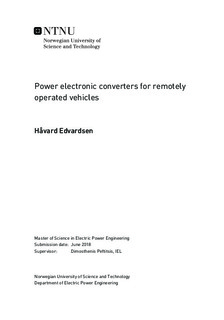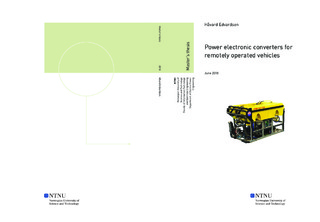| dc.description.abstract | Remotely operated vehicle (ROV) is considered a key component for the subsea industry. Not only for the oil and gas industry, but also for inspection of underwater installations, subsea installations of HVDC cables, object location and recovery, diver observation and assistance and so on. The ROV will play an even more important role in subsea development in the future, as the depths of interest are getting deeper.
Most commercialized ROVs today, utilizes hydraulic systems for the propulsion and tooling equipment on board. However, the industry is starting to shift focus over to fully electric ROVs and the possible advantages it presents. Lower maintenance cost, higher reliability and efficiency, and thinner and cheaper umbilical are the main driver for this shift. As the industry is moving towards operation in deeper waters than today, the shift to fully electrifying the ROVs is even more crucial.
This thesis investigates the converter suited as the main converter for the ROV. The main converter is supplied with medium voltage from the umbilical and it distributes a low voltage to the equipment on board the ROV. The converter has to be dimensioned to handle the entire load of the ROV. Since the hydraulic power unit, which is the biggest load, is removed from the ROV when fully electrifying the ROV, the power rating for the ROVs does not need to be as high as the hydraulic ROVs. After discussion with the industry, a 100 kW power rating has been used for this thesis.
In the literature study leading up to this thesis, a new electrical system was proposed for the fully electric ROV. The study points to several benefits for the electric ROV and suggests that the ROV is supplied with a MVDC at 3 15 kV through the umbilical and a LVDC at 0.4 0.7 kV as the power supply on the ROV. The study also suggest that a galvanic isolation is needed to ensure safe operations and obtain higher reliability. This means that the main converter should be designed as an isolated DC/DC converter.
Five different converter topologies have been presented and discussed. They all have their advantages and disadvantages. One of the most important criteria for ROV application is weight and volume. Converter efficiency is second priority. This means that the converters should be optimized to avoid high capacitances and inductances.
Two of the presented topologies are further designed, simulated and evaluated for the ROV application; the dual active bridge and the modularized dual active bridge. Since the voltage or switching frequency is not clear at this point, several voltage and frequencies ranges has been tested in order to optimize the design.
The result from calculation and simulation shows that by choosing the modularized dual active bridge the volume can be decreased by more than 57 % compared to the dual active bridge. The reason for decreased volume is that the modularized dual active bridge can operate with a much higher switching frequency due to low voltage switches. By increasing the frequency, the passive components such as capacitors, inductors and transformers can be significantly reduced. However, this thesis has not been able to identify the complete volume of each converter. This means that the total volume of the converters in this thesis may be higher. Still, the conclusion from this thesis gives an indication for further research and development for the ROV application. | |

